December 19, 2006
Deviwo.org is in orbit, Thanks to Saturnalia
This week our website was officially launched thanks to the ice cold web skills and fluffy warm generosity of my friend Will Swofford here in Brooklyn, NY.
December 15, 2006
Film on Students' Photo Exhibit at Univ. of Ghana
Shot by Godwin Azameti in January 2005, this two part series documents the event like only Godwin can. Includes speeches from parents, teachers, students and visitors, musical performances by Agorsor, student photos, and candid shots from throughout the day. You had to be there...now you are.
Part 1
Part 2
Part 1
Part 2
December 9, 2006
Why We Are...Where We Are
"The naked babies stare back at you, but does that mean they have consented?"
-Dale Massiasta. Founder of the Blakhud Cultural Research Center in Klikor, Ghana
Ghana Through a White Man's Lense

In 2004, when I moved back to Ghana, one of my favorite places to go in Madina was after social welfare Taxi Rank, on the edge of the community where the houses stopped and the bush began. It was the closest my little town of 50,000 came to feeling like a village. There was a bench looking out at at a distance on an area of razed land where people dumped and burned trash. The rising smoke always gave it this kind of eery other-worldliness. All the structures were piece-mealed together. Scraps of wood and tin were bound together to form houses, fences, chicken coups, gin shacks.
I often went and sat back there alone to watch the people coming in from their farms in the evenings. At dusk, the sounds of the pentecostal church choir floated through as children carried buckets of water to their homes.
No one ever questioned me as to why I was there. Sometimes I sat alone quietly and wrote. Other times, my Ghanaian friends in the area would pull out a bench and we would share a smoke and some conversation.
Once, I brought my camera out at dusk. The smoke was rising off the trash yard and the goats were milling around. Someone had thrown out this giant television and I loved seeing an instrument of technology, this living room centerpiece so out of context--no place to plug it in and even if there were one, you had this sense that the screen would display this very yard, the smoke rising up.

I started taking pictures. I wanted to capture the order and beauty of a place where pieces of things are discarded, found and re-formed. Old car tires lie buried in the soil to mark the beginning and end of perfectly swept clay back yards. Refrigerators run on car batteries. A television is a box of glass.
That evening, a man approached me and asked me why I was taking pictures of such a dirty place. I recognized him immediately as the pastor for the church adjacent to the palm farm.
"This is why the world believes we are uncivilized," he said. "Because this is the photograph that you white people always want to take. You don't snap us wearing our nice dress, sitting in church, building schools, in our congress halls. You don't want to see us that way."
My friends tried to defend me. I told the pastor that I had been snapping all kinds of pictures--street scenes, weddings, funerals--everything! And I was even teaching children how to take pictures and document their lives. I tried to explain that I actually lived in this neighborhood, that I had been there for over a year and that I came to this spot to sit because I loved being there.
The pastor insisted I put my camera away. To him, I was any white man in Africa, all that had come before me and all that would come after. Our pictures show up in magazines with the caption "crisis" and we never show up again.
What can I tell you of my time in Ghana? I have never been calmer, never slept deeper and dreamt more vividly. I have never felt so accepted into any community. And I have never been more frustrated, more restless, alone, confused and misunderstood. There were so many times I got caught up in the desire to put a finger on something I didn't understand. To say, "oh, this is this."
I lived and worked with Ghanaians who I loved and respected. They taught me how to walk, how to dress, how to eat, how to be a host of others in our home--the rules of a culture. As a giant white infant, they forgave me when I fell down and drooled on myself. I felt for the first time what it is like for people to assume things about who I am because of my skin color. Most people were convinced before even speaking with me that I was rich, smart and lazy.
I grew to trust certain people and led them to trust me. Sometimes we disapointed each other and sometimes we found a way to give and receive on equal ground. I learned to laugh at myself. I didn't want to be the only one not laughing. I began to see that what I wanted and what I needed were completely different things. And I learned over and over, as I crashed into the same walls, to be quiet, watch and listen.
The Story being told by us to us.
"If the photographer takes the picture, the person who looks at the picture will know the truth. And will know what he can say and what he will not say. A liar will come to you and say whatever he likes, but you know that the person is lying because of the picture...if the photographer shows the picture to you and says what he saw, you will believe him."
-Edward Chao, 12 years old. Accra, Ghana.
If only some of us are holding cameras, who's story gets told? If Only some of us can get a ticket and gain visa entry to "discover" a new part of the world, what do we explorers take with us and what do we leave behind? What moving image do we see in front of us that makes us want to--click--freeze time and say, "that." That was Africa.
I was--click-- there. That was my interesting life.
At our best, Our understanding of Africa falls into neat categories that help us to sleep at night. We're in love with the idea that there is magical wisdom buried in the deep dark jungle--only the Africans know which roots and how to dig them up--and its enough knowing that this is out there somewhere. It tickles us to think about the bushman who finds the Coca Cola bottle that fell from the sky. What purity of heart he must possess. What beautiful children he has, such innocence and strength in their small bodies. We are able to believe in this man because--as the script shows-- we are flying so high above him and have accidentally convinced him that we are his God.
"As i landed in the African night..."
Our optical zoom project false proximity to a culture in which we are only visitors and to our subjects who are subjected to our instruments, our own magical powers of mass duplication. We believe discovery is our duty. And we are not surprised when our photographs tell us what we already know: it's hopeless in Africa. Hopeless without us, our technology, our opinions, our God, and our AID.
"...There, with the calloused palms of poverty laid bare before me, I began my important research..."
And so we feel we must continue to land and brave the dark jungle, to live to tell the stories from the front lines: war, starvation, humans who live in filth, children who live without, mutilations.
In high definition all of this suffering is simply immaculate.
This is what the pastor was trying to tell me. He was saying, you've already taken that picture. And while he may have made a few of his own assumptions about me as an oboroni, a white man, I agree that there needs to be a shift in point of view, a transformation in the way the west sees Africa, the way Africa is allowed to see itself. Africa is a massive continent. It is not something to be conceieved of all at once. There is vast space between the neat categories we have come to rely on. There are people walking and talking and changing and staying the same. There are millions of stories and not one of them will fit into a three column spread.
A New Narrator
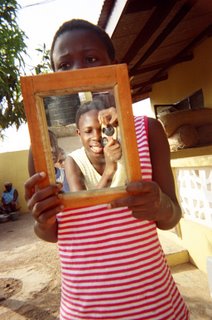 This project is the story of seventeen Ghanaian children who were given cameras by their North American English teacher and told to document their world. These were children who basically did what they were told but found a way to transform an odd assignment, a strange and foreign idea, into something that belonged to them. This was their discovery. It is not the story of Africa, West Africa, Ghana, a city called Accra, Madina, or Zongo Junction--though you will find them all there in pieces. Their assignment was never to dispel the myths of their region or enlighten the West by setting the record straight. These are fragments of a whole and should be taken as such. They snapped these pictures for themselves, for their friends and their families. They traded them in the school yard and laughed at the faces they got caught making. They bothered me daily for their next assignments.
This project is the story of seventeen Ghanaian children who were given cameras by their North American English teacher and told to document their world. These were children who basically did what they were told but found a way to transform an odd assignment, a strange and foreign idea, into something that belonged to them. This was their discovery. It is not the story of Africa, West Africa, Ghana, a city called Accra, Madina, or Zongo Junction--though you will find them all there in pieces. Their assignment was never to dispel the myths of their region or enlighten the West by setting the record straight. These are fragments of a whole and should be taken as such. They snapped these pictures for themselves, for their friends and their families. They traded them in the school yard and laughed at the faces they got caught making. They bothered me daily for their next assignments.I chose to make this site and develop this book and other ways to share their work with a larger audience because I adore these kids, and I believe that what they created together is important. I wanted them to have a record of what they did, something to hold. And I too wanted something to show for my work in Ghana, for this is also, of course, the story of my interesting life.
-SB December '06
November 30, 2006
Godwin Azameti Comments on Student Photos from Accra
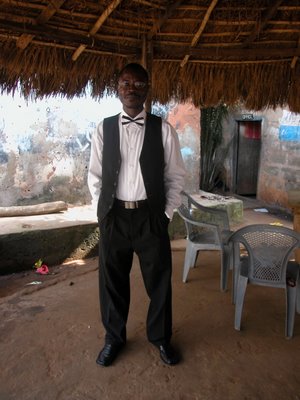
Godwin Azameti is an exprienced photographer and videographer in Ghana. He is an ewe from Klikor, Agbozume in the Volta Region of Ghana. In addition to his role of co-director of the Blakhud Research Center in Klikor, he owns and runs a shop in Accra that specializes in photographic services. He is a passionate and keen documentarian who, besides being able to fix just about anything that you ever thought was broken, has been a tremendous help throughout this project as a teacher for the kids and as a consultant for the Accra exhibition in January 2006. He was kind enough to assist in the editing process by airmailing his comments overseas to me in Brooklyn.
Here are a few examples of the spreadsheets he creeated to give me and Brendan more perspective on what we are looking at as we create layouts for the book...
EDDIE
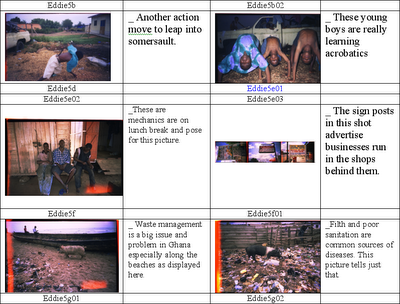
AISHATU

To contact Godwin in Accra, Ghana: Gazameti@yahoo.co.uk
November 9, 2006
Serafina Bathrick comments on student photos from Wisconsin
A lot of people have been helping out in the editing process. Among them is my Aunt and Brendan's mom, Serafina Bathrick. We sent her some rough proofs we made in June '06 and she's been writing back to us about certain images that stand out for her. She has all kinds of impressive credentials I could mention, but just read and see why I'm so glad that she is a part of this project.
B and S--This is so much fun and I find myself thinking all day about these images and about your task as you organize and present them....
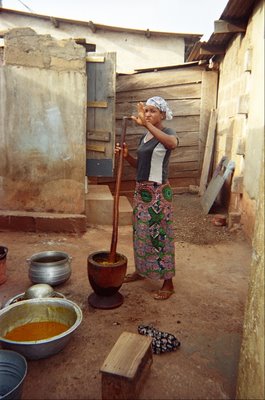
SUMAIYA #2e01, roll 2--These two photos of the woman mashing somethng in a pot-lovely how the photographer stayed with her subject and got an animated gesture (and probably some words) and then got the perfectly composed shot next.

This refusal to let one image say it all is something I like very much and may be suggestive of what we do when we think about moving images and the need to see what went on before and after THE shot was taken. Communicates a greater sense of time, and close looking and listening. Granting full meaning to the shot that came before the shot seems like an expansive way of seeing.
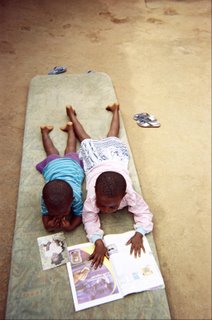
THEO 15, Roll 1-Wonderful composition--playing with frames and rectangles. By using a high angle shot, he catches the boys lying on a mat and reading books that all refer to the picutre frame itself. The term for this is mise-en-abime, and its used constantly in classical cinema to emphasize the "picture-frame" as a "natural" entity, almost like the human eye. Great shadow play of light and the two pairs of shoes are just perfect--outside the mat as frame.
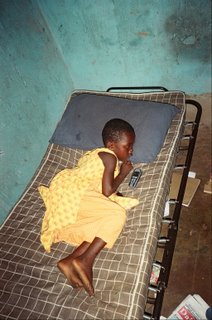
#15, Roll 2. Theo gets some of the same intensity by framing the figure on the bed (her head framed by the pillow-rectangle)
and by choosing the high angle shot he gets that play with frames. I am not trying to say he is conscious of this, but rather that when a person uses a camera and looks through a lens and sees a frame, there is an inclination to make that device obvious to selects and frames his subject. This is but one example of how a camera-consciousness emerges in the act of photographing and in the act of looking at a photograph--its all about re-presentation. I have been emphasizing this aspect of these images, because to me, its what makes for a specific "way of seeing".
PATRICIA
-#7,8,9,10, Roll 2. As usual I am drawn to these series images, where there is a sense of movement and, in this case dance and performance. The addition of a second figure in the last shot suggests the power of the camera to recruit new performers-- and suddenly, there is a fellow dancer. The visual interest of the empty clothesline and the empty space really gives this little dancer a fabulous stage. Patricia has a good eye for those things.


SELINA -1b03, Roll 1. The well-to-do -man of a certain age with his car, house and satellite set up is situated perfectly by this shot. He even stands to the side of these powerful symbols, as though to assume a somewhat humbler place (and we assume he likes leaning on the wall) Terrific composition and content too.

STELLA-#1, Roll 5. Another car tire shot. This time alittle boy who is almost the size of the tire he is rolling. Nive shadows and suggestion of adults present, but not interfering with this boy's mobility.

-#3, Roll 5 Woman in front of pink house with red bouganvillia. (spelled wrong) Fascinating composition, colors, and pose by the subject. Part of that series includes the next group of women with plants and flowers. #s 4,5,6.

NELLY
I like her short narrative about her sister Yaa and her son Ben. Its a fine photo--balanced and beautifully composed, with the mother and child holding their own in front of all that stuff-barrels and towels and coffee cans. I like the way the photo tells the sister's story too, how she holds the soapy baby so that he faces the camera and she faces him. (the vertical shot works better, it has no number) Added to what Nelly says about loving her and feeling loved by her, its a very complex portrait.

"Mother Cooking for Aunt" is a lovely two-part series on Roll 2. Great sense of the space and the work and the body of the working woman as she wrestles with that pot of something thick and white
VICTORIA
Victoria's shots with many people and lots going on are hard to read in this format. Some look really interesting, and she is one of the few who is willing to take on the levels of complexity involved in these compositions. She works carefully with camera angles and has a real sense for how to frame a shot. Daring and encompassing.
-#10, Roll 1-What a gorgeous shot! Camera angle is all encompassing, and look how much is going on with these two figures in this complex space. Table top and covered bowl, bucket, vertical line of light--shape of the slip on the woman in the foreground--just beautiful visually.
Joseph Teye
As I read Joseph Teye's narrative, I am struck by how he is very conscious of the camera as a presence, a force, even a personality in the situation that is unfolding. His sense of telling the story with the camera and with words that complement and position the camera is impressive. I am wondering about this as an organizing principle for your final cut--which of the students is able or interested in bringing the camera, as a character, into the story. How does that determine a camera style that might differ from the people who write about the camera as a hidden extension of themselves, not so much as a part of the social fabric.
-"the car tire pushers" #6 and #7, Roll 1 are both wonderful images, and the narration that accompanies them works so forcefully to show how Joseph experiences the camera as a an element or even a character that moves the story.
-pulling the vines is just plain a great shot # 17, Roll 1. The lighting, the movement of the figure, and of course it also goes along with the story that he tells about collecting goat feed. Is there a photo of the goats? Oh yes, I see one with a goat and a chicken just out and about. # 1, Roll 2. Nice positions of figures in this shot.
-I love the "God is King" (# 3, Roll 2) yams and rice shop! Wonderful sense of movement and action about the way she serves and poses as a server.
B and S--This is so much fun and I find myself thinking all day about these images and about your task as you organize and present them....

SUMAIYA #2e01, roll 2--These two photos of the woman mashing somethng in a pot-lovely how the photographer stayed with her subject and got an animated gesture (and probably some words) and then got the perfectly composed shot next.

This refusal to let one image say it all is something I like very much and may be suggestive of what we do when we think about moving images and the need to see what went on before and after THE shot was taken. Communicates a greater sense of time, and close looking and listening. Granting full meaning to the shot that came before the shot seems like an expansive way of seeing.

THEO 15, Roll 1-Wonderful composition--playing with frames and rectangles. By using a high angle shot, he catches the boys lying on a mat and reading books that all refer to the picutre frame itself. The term for this is mise-en-abime, and its used constantly in classical cinema to emphasize the "picture-frame" as a "natural" entity, almost like the human eye. Great shadow play of light and the two pairs of shoes are just perfect--outside the mat as frame.

#15, Roll 2. Theo gets some of the same intensity by framing the figure on the bed (her head framed by the pillow-rectangle)
and by choosing the high angle shot he gets that play with frames. I am not trying to say he is conscious of this, but rather that when a person uses a camera and looks through a lens and sees a frame, there is an inclination to make that device obvious to selects and frames his subject. This is but one example of how a camera-consciousness emerges in the act of photographing and in the act of looking at a photograph--its all about re-presentation. I have been emphasizing this aspect of these images, because to me, its what makes for a specific "way of seeing".
PATRICIA
-#7,8,9,10, Roll 2. As usual I am drawn to these series images, where there is a sense of movement and, in this case dance and performance. The addition of a second figure in the last shot suggests the power of the camera to recruit new performers-- and suddenly, there is a fellow dancer. The visual interest of the empty clothesline and the empty space really gives this little dancer a fabulous stage. Patricia has a good eye for those things.


SELINA -1b03, Roll 1. The well-to-do -man of a certain age with his car, house and satellite set up is situated perfectly by this shot. He even stands to the side of these powerful symbols, as though to assume a somewhat humbler place (and we assume he likes leaning on the wall) Terrific composition and content too.

STELLA-#1, Roll 5. Another car tire shot. This time alittle boy who is almost the size of the tire he is rolling. Nive shadows and suggestion of adults present, but not interfering with this boy's mobility.

-#3, Roll 5 Woman in front of pink house with red bouganvillia. (spelled wrong) Fascinating composition, colors, and pose by the subject. Part of that series includes the next group of women with plants and flowers. #s 4,5,6.

NELLY
I like her short narrative about her sister Yaa and her son Ben. Its a fine photo--balanced and beautifully composed, with the mother and child holding their own in front of all that stuff-barrels and towels and coffee cans. I like the way the photo tells the sister's story too, how she holds the soapy baby so that he faces the camera and she faces him. (the vertical shot works better, it has no number) Added to what Nelly says about loving her and feeling loved by her, its a very complex portrait.

"Mother Cooking for Aunt" is a lovely two-part series on Roll 2. Great sense of the space and the work and the body of the working woman as she wrestles with that pot of something thick and white
VICTORIA
Victoria's shots with many people and lots going on are hard to read in this format. Some look really interesting, and she is one of the few who is willing to take on the levels of complexity involved in these compositions. She works carefully with camera angles and has a real sense for how to frame a shot. Daring and encompassing.
-#10, Roll 1-What a gorgeous shot! Camera angle is all encompassing, and look how much is going on with these two figures in this complex space. Table top and covered bowl, bucket, vertical line of light--shape of the slip on the woman in the foreground--just beautiful visually.
Joseph Teye
As I read Joseph Teye's narrative, I am struck by how he is very conscious of the camera as a presence, a force, even a personality in the situation that is unfolding. His sense of telling the story with the camera and with words that complement and position the camera is impressive. I am wondering about this as an organizing principle for your final cut--which of the students is able or interested in bringing the camera, as a character, into the story. How does that determine a camera style that might differ from the people who write about the camera as a hidden extension of themselves, not so much as a part of the social fabric.
-"the car tire pushers" #6 and #7, Roll 1 are both wonderful images, and the narration that accompanies them works so forcefully to show how Joseph experiences the camera as a an element or even a character that moves the story.
-pulling the vines is just plain a great shot # 17, Roll 1. The lighting, the movement of the figure, and of course it also goes along with the story that he tells about collecting goat feed. Is there a photo of the goats? Oh yes, I see one with a goat and a chicken just out and about. # 1, Roll 2. Nice positions of figures in this shot.
-I love the "God is King" (# 3, Roll 2) yams and rice shop! Wonderful sense of movement and action about the way she serves and poses as a server.
February 22, 2006
Farewell Ghana...But First, Party
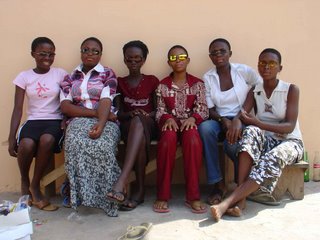
I decided to throw a party at my house. I'm not sure how they found out, but some of my students showed up the afternoon of the event. Actually, it was Amevi who told them. It had to have been Amevi. They were all dressed up and I told them they were a little early and then I put them to work. We had to pick up 14 crates of beer and 6 crates of sodafrom the shop up the road. They carried them-- two kids to a crate--back to the house and stacked them in the living room. Then, they swept the compound, fetched water for cooking, and organized the coolers.
I realized I still had a dozen sunglasses left over from about 6 dozen my grandfather had given me before my trip over. I bought them sodas and let them pick which glasses they wanted.

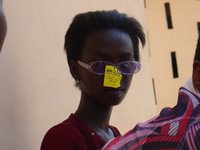
The party was great. Everybody from the neighborhood came. Georgina (...The Gina School) showed up with her whole family and an enormous amount of really good food. Godwin showed up with my camera and hired floodlights so that he could videotape the entire event. Sorlem Agbesi and his Borborbor drumming and singing group performed for hours, as did Heawle Sounds. People danced until it hurt.
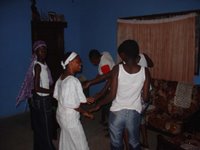 The kids found their own spot in the living room. At one point I broke out some extra Kodak disposable cameras and there was this wave of children running around snapping photos in people's faces. I didn't get many of those cameras back.
The kids found their own spot in the living room. At one point I broke out some extra Kodak disposable cameras and there was this wave of children running around snapping photos in people's faces. I didn't get many of those cameras back.
February 12, 2006
Arrangements before Leaving Ghana
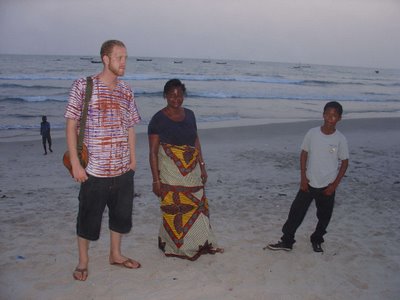 Sam, Elizabeth, and Eddie. Photo by Godwin Azameti
Sam, Elizabeth, and Eddie. Photo by Godwin AzametiI enrolled Eddie in the Hannah School Complex off of New Road in Madina. I had considered enrolling him in Gina's school where I taught, but the walk to Zongo Junction is too far. I don't want his grandmother shelling out money every week for bus fare.
It's sort of a leap from his old public school, Madina Estates, to this--an enclosed compound with a library, computer classes, other smart kids, even rich kids. I had a really good talk with some of the faculty including Teacher Jane, one of the administrators there. I liked the feeling I got. I liked the way they talked about education. I liked that its going to be a challenge for him. Eddie got used to being one of the smartest kids in his old school and sometimes I could tell that he wasn't even trying. Half the time the teachers at his old school wouldn't show up--perhaps because they weren't getting paid or paid enough--and then Eddie would go roaming through the neighborhood. This is going to be more of a structured environmentt for him and that's a good thing because its hard for his Grandmother, Elizabeth, to keep track of him all the time.
I took Eddie on Friday for his entrance exams and of course he did fine. He's really excited about the school but I told him it's not a free ride, that I'm going to be checking up on him through his teachers, his grandmother, and Godwin. Most kids in his neighborhood will never get an opportunity to go to one of these kind of prep schools. I want him to take this seriously, to understand the sacrifice his grandmother is making for him. I know he knows, but he's just a kid and he runs off and gets in trouble and the fact of the matter is that she needs him around the house to help out. She needs it or this whole thing is not going to work. She talks to me about this just about every day. She knows I've got his attention.
I took her and Eddie to Godwin's house in Accra on Monday. He lives right on the beach. We sat and talked about what will happen after I'm gone. I want Godwin to be my eyes and ears on the ground. He and I are in constant email contact andI trust him to monitor any and all transactions with the school, to retain records, and give me updates. Godwin and Elizabeth speak the same native tongue and that's good because my communications with her are often limited. I wanted her to know where Godwin lives, to understand his role in this whole thing, and I wanted Eddie to see the systems being set in place--his extended family watching over him. It was really a beautiful night and Godwin's wife prepared wonderful food--Akple, my favorite. We drank Star Beer at a Spot on the beach and I felt really happy and also incredibly sad. I can't believe that i am leaving them.
Eddie took this picture of us on the road walking back to Godwin's house. I really love it.
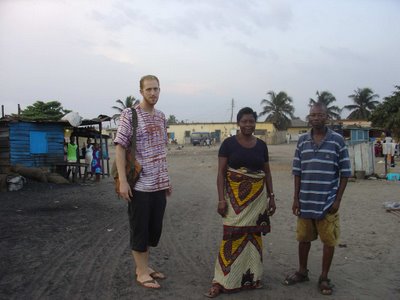
January 31, 2006
Photo exhibition at the University of Ghana
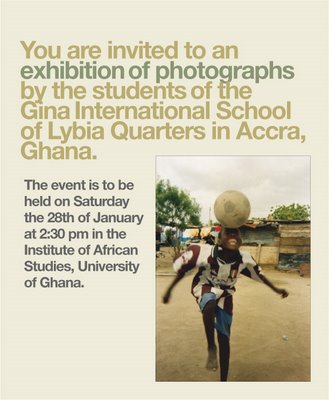
A lot has happened in the last few months. In January we held an exhibition of
the students’ work at the institute of African Studies in the University of Ghana. For those of you who weren't able to make it I'd like to share some of the highlights with you. The School for International training generously volunteered their classroom in the Institute of African Studies for us to use as the gallery space. Special thanks to Gavin Webb, Yaw Gyamfi, Kokroko Gyamfi, Clara Nsiah, Godwin Azameti, Anita Lynn Tawiah, David Chan, Georgina Dorkuvie, Agbekor Gidi, Collins Amlalo, Danny Abotei and Bob Heller who volunteered their time, energy, resources, wisdom, and magical powers to make the event possible. Since the classroom was occupied during the week leading up the event, we had about twenty-four hours to set up the exhibition. Many of those people I mentioned above spent the wee hours of the morning before the exhibition hanging black cloth from the walls and mounting 8x10 prints with selected short passages created by the students.
At one point late in that night, we went out to take a break and get a cold drink. When Yaw and I returned to the courtyard a half hour later, the gates to the Institute of African Studies had been locked, presumably by the late-night grounds crew. We scoured the entrances for an opening, but all gates were secured by pad-locks. At this time, with nearly half of the exhibition still unfinished, I began to breathe very heavily—mostly just inhaling. Yaw didn’t seem notice and disappeared into the darkness. Moments later he was calling me from inside the gates, dangling a loose padlock on his finger.
“I used some herbs from the bush,” he explained, grinning.
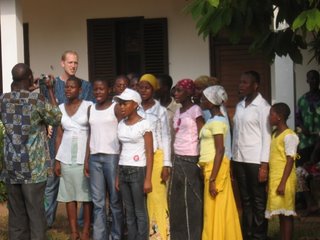
The event drew a diverse mix of people including the teachers at the Gina School, the students, their families and neighbors, members of the university community, photographers, ex-pats, pan-africanists, and a random assortment of folks who had just seen the posters plastered around town. After threatening rain for days, the overcast skies provided needed shade for the attendees mingling in the courtyard throughout the afternoon. The students’ sang their school anthem and their favorite pop song to kick off the program.
Coming off of two days straight with no sleep and having forgotten to eat that morning in the printer failure/ general mayhem leading up the event, I attempted to make a speech to the crowd and forgot most of the essential points I had spent month preparing. I must have reasoned that the best way to prepare myself for this nerve-racking moment was to simply not prepare myself at all. What I remember most is that, as I began to speak,
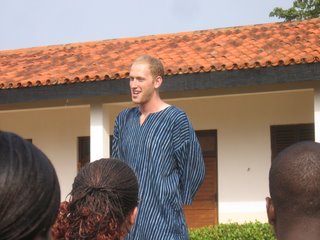
the equatorial sun came out and burned away the clouds. There I stood squinting, dazed, and wondering how to at least make myself short if not sweet. What I did remember to do was --and this was really the whole point of holding the event-- to thank the families for their patience and participation in this project over the year, as often they were subjects in their children’s pictures or were the photographers themselves. I thanked the Gina school and its faculty for making music, dance and drama a part of the curriculum and for embracing the idea of adding photography as an after-school program in the Junior Secondary. In my closing remarks I posed the question “Why are pictures important and why is it important that children take pictures?” Beads of sweat pouring down my face, I searched for an answer to this question.
Godwin Azameti,
 who has collaborated with me in teaching the kids and planning for the exhibition and who had been videotaping the event thus far, came to the rescue. Handing me the video camera, still running, he delivered one of his many eloquent speeches. This and other excerpts are taken directly from the video transcript.
who has collaborated with me in teaching the kids and planning for the exhibition and who had been videotaping the event thus far, came to the rescue. Handing me the video camera, still running, he delivered one of his many eloquent speeches. This and other excerpts are taken directly from the video transcript.“Photography, as a matter of fact, in our society is not respected. You see people hanging cameras from their necks and you don’t give them the respect. But as I am a photographer, Sam brought this idea that he wanted to teach children photography. Why this idea? Well, children see things in their own perspective and adults also see things in their own perspective. But children have some funny ways of coming by certain things. And when you look at it, you sit back and analyze it, you see a lot of wisdom in what children do...the photographs capture the photographers
themselves.”
I was pleased to hear Godwin talk about his passions as a film-maker and photographer in Ghana—using images to tell stories and preserve history and culture --and to acknowledge that the students have something important to offer their own community as well as the rest of the world. This is something he had shared with the students in class, but it seemed an especially important point to be raised at this event.
Next up on the program, I called Stella Apeke, the oldest girl in the class and one of the strongest student photographers, to deliver a short speech she had written. There was some murmuring in the crowd and Stella whispered nervously that she had forgotten it at home. Visibly disappointed, I said something to the crowd like, “Well, there’s no handing that one in late, so I guess you failed.”
I wrapped up the first phase of program and encouraged everyone to move their chairs to shady places. Being the baggy-eyed grump that I am, as the students gathered in the S.I.T. library to bring out the food, I scolded Stella in front of all her classmates for her carelessness. “I didn’t forget anything at home,” I told her.
The students then served food and drinks to the guests and the party began.
Agorsor, a neo-traditional dance band, provided live musical entertainment with a thrilling guest appearance by my housemate and master drummer, Francis Akotuah, which really got the party jumping. The students and guests danced, ate, and wandered in and out of the gallery space.


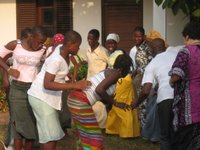
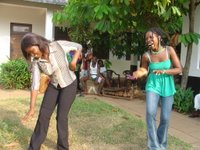
After a few hours, the chairs were re-assembled and the program resumed with a speech by the Georgina Dorkuvie, the founder and proprietor of the Gina school. She thanked me for what I was doing for the school and the students. She then thanked all the parents for coming and scolded those parents who had opted not to attend or had left early.
I asked if anyone else would like to say anything to the crowd. Stella Apeke stood up, walked to the front of the crowd and, without any notes, delivered her speech:
“Photographs are important. And photographs are important to me. When you are growing, you snap pictures of yourself to remember when you were small. Sometimes, I look at the time when we were babies there in the picture, and I just laugh because I’ve grown. Scientists, Engineers and doctors take pictures of the things they’ve made and show it to the world. Maybe you’ve not seen the president of the United States but because his photograph is all over the world, you can identify him. Thank you.”
The crowd cheered including a standing ovation from Stella's classmates. More speeches began pouring in. Eddie's grandmother came up and raised her favorite gospel song, Akpe Na Mawu, while the other Ewe people in the crowd sang along in their common language. Then Teacher Hayford performed a monologue in Shakespearian fashion, entitled “if I had a voice” about his hopes for the future of the nation:
“Oh, if I had a voice. If I had that loud and sounding voice to call on decision makers to make policies that will enhance the growth of our people. I wish I had a voice. That loud and sounding voice to tell parents to spend their last earnings towards the education of their young. Oh, I wish I had that voice again to tell my young people to arise and shine and build this nation. I wish I had that voice to call all the society to work toward the development of our people. Amen.”
One man, Berlinda's father I believe, came up and delivered a speech that included standing on a chair and later rolling on the ground, imitating a photographer in the act of finding the perfect angle for a shot. "As for photographs," he said, "I like
them too much."
The crowd roared with laughter and applause. Numerous other speakers, including University students and faculty who had just been passing by the courtyard, stood up and praised the students’ work. When it was getting dark, I decided it was time to close the ceremony. Seeing as most events in Ghana open and close with some kind of prayer and taking into consideration that there were many different religions in the school community, I decided to improvise a non-denominational prayer. Somewhere in the middle of my ramblings about the magical wonders of the trees and the dirt, I noticed my face was tingling and I was seeing little lights out of the corner of my vision. I decided to finish up – and everyone joined me on this one-- with a simple “amen.” The crowd slowly dispersed. The students stayed on later to clean the area, stack the chairs, take their pictures down from the wall, and return the coolers and catering supplies to campus canteen before finally asking permission to return home.
At this point my wonderful beautiful friend, Clara Nsiah, who had helped enormously in the planning of the event (no chairs or food without Clara), tapped me on the shoulder and handed me a plate of rice and chicken she had set aside for me earlier that day. “Go
sit down and eat this,” she said.



Subscribe to:
Comments (Atom)
